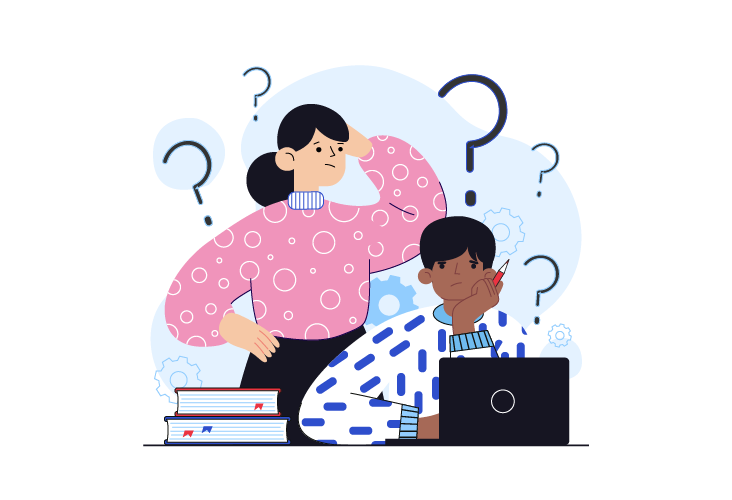Most college students in the US have an average student loan debt of around $29,000 – that’s no joke.
So, if you thought applying for college was hard, we’ve got news for you! College is super competitive, and most students don’t know what they’re getting themselves into when they apply. Sure, you get a degree at the end of the day, and considering the significant pay gap for graduates vs. dropouts, it does seem worth it. Still, these rewards only matter for students who graduate successfully.
It’s no secret that a large percentage of students (around 40%) drop out of college without getting a degree. This means they get the debt without any of the benefits, and that enters them into a vicious cycle. Debt affects their credit score, which invariably affects their quality of life – and that also, ironically, affects their ability to pay back the money they owe and get out of this situation.
The point is students invest a lot in going to college – time, money, and effort. And not all of them graduate. Let’s face it: college is a giant leap from high school. It’s a drastic change, and not all students are ready for it. We’re not saying institutions don’t try to soften the blows – they really do, but the stats don’t show much improvement.
So, we went all out to make a list of the things students wish colleges knew.
#1 Online Classes are More Engaging
Online classes are stigmatized because most people think they’re not as interactive or engaging as a traditional classroom. But if there’s one thing the pandemic proved, it’s that online classes are just as good, if not better, than a regular classroom. In fact, studies show 70% of students agree online courses are just as good or better than in-person classes. And almost 26% of students claim to learn better online. They even want their instructors to include some online classes during in-person courses. eLearning platforms for students provide convenience, flexibility, and accessibility to both students and teachers. As for not being able to connect with teachers, student success platforms like SimpliTaught offer live chat and video conferencing options so students can easily contact our educators with their questions.
#2 Only 20% of Students Actually Understand their Professors
We know this might seem like a made-up statistic, but it’s actually not. Traditional classrooms have always operated at questionable efficiency, but for a long time, we’ve believed there wasn’t much we could do about it. This means students must put in extra hours trying to self-study while getting little to no support from their instructors and institutions. It’s not that the instructors and institutions aren’t providing support – it’s just that the support they provide is different from the support the students need, and it’s sufficient for only 20% of students. Now, we have a much clearer picture of the problem: learning and teaching styles in the classroom don’t always match. In fact, studies cite students claiming “the teaching style doesn’t work for me” – making this a major barrier to learning. And the numbers are even worse for marginal groups like LGBTQ students.
So, we need a way to match students with the kind of content and instructions that help them learn best – and online learning for students effectively gets the job done! Different students learn differently; different teachers teach differently, and online learning platforms like SimpliTaugt bring them together!
#3 Most Students Hide Learning Disabilities – But They Still Need Support to Pass
High schools actively work to identify students with learning disabilities, but colleges and universities don’t. Instead, they require students to self-identify their disabilities to get the support and academic accommodations they need. Unfortunately, when you look at this from a college student’s perspective, acknowledging or disclosing their disability will put them in a vulnerable position in front of their peers. They don’t want to feel isolated – they just want to be “normal.” And, of course, there’s nothing wrong with asking for help when you need it, but these students are still young, and many of them decide not to disclose their disabilities to their college. This means they are not eligible for subsequent accommodations. Still, covering up a disability won’t make it simply go away, and these students have to suffer in silence. When colleges integrate adaptive learning solutions for students, they can especially help students with learning disabilities receive the support they need to pass without needing to put themselves out there.
#4 College Students Can Only Concentrate for 10-15 Minutes at a Time
The average attention span for humans is collectively decreasing, and college students can only focus for around 10 minutes at a time. This means they won’t understand what the teacher says past the 10-minute mark. Social media addresses this problem through microcontent. Similarly, microlearning is an effective learning strategy for students because it breaks down difficult concepts into shorter bits that are easy to read and understand. So, rather than spending hours on a single concept, students can spend 10 minutes on each segment to fully understand the same concept (in parts) but much faster!
#5 They Need to Take Breaks Between Lectures
Shorter attention spans also mean students need to reset their brains by taking breaks. This helps improve focus, increase productivity, and manage stress. In fact, research proves taking breaks can actually increase efficiency. Online learning platforms for students (like SimpliTaught) provide flexibility, which means students can take breaks as needed to avoid feeling overwhelmed. And, of course, this improves retention as well.
#6 Sometimes Learning Materials Are Too Hard to Understand
College students often complain about classes being too difficult. Unfortunately, they’re mostly dismissed because we think they’re just making excuses. But the point is we all have different aptitudes for learning. That’s not to say some people are dumb – different is not bad; we all just have our own strengths and weaknesses. We can’t see all sides of a cube at once simply because we’re on the other side. So, the same piece of content can be easy or difficult to understand for different students – and none of them is wrong or “not trying hard enough.” They’re just different. Remember when we talked about unique learning styles? Well, this is kind of the same thing.
One of the most effective learning strategies for students is personalized learning. SimpliTaught, one of the best online learning platforms, delivers customized learning experiences using technology to understand unique learning patterns and accommodate individual students accordingly.
#7 Deadlines and Workload Are Often Unrealistic
College students are super busy, especially if they’re working part-time. Besides attending classes and working on assignments, they also need to manage their time between jobs and relationships. What’s more, a majority of working students have menial jobs like waiting tables, washing dishes, clearing floors, washing cars, and even babysitting. This means these students end up extra exhausted because they’re always on their feet. So, it makes sense why studies report at least 57% of college students want more flexible deadlines. As for workload, remote learning offers flexibility because students can take their time to learn and understand concepts, rather than trying to cram information in a “now or never” manner even when their brains are not ready for it.
#8 Many Students Can’t Decide on a Major
When you’re deciding your major in college, you’re basically deciding what you want to do for the REST OF YOUR LIFE – that’s a lot of pressure, especially for a 20-something who just got out of high school! Most college students feel overwhelmed about choosing a field, but working with an academic counselor can help them weigh their options.
#9 Lifeload is a Barrier to Learning
Lifeload is the cumulative pressure students have in their lives, which includes college, jobs, family, health, and whatever else is stressing them out. Mental health is super important yet often overlooked. However, a student who’s mentally or physically exhausted by lifeload will not care about how Python syntax is different from R or why Gatsby couldn’t put his past behind him – and it’s not their fault. They’re only human, and they have real problems – they can’t go around parading happily when their life is a mess. They’re just trying their best (probably). But this means they don’t have hours to spend trying to understand the same concepts, especially if it doesn’t match their learning behaviors. Instead, they need a system that adapts to their academic needs. Adaptive learning is an approach to adjust content difficulty to suit individual students so it makes more sense to them.
#10 Students Want Educators to Be More Accessible
Another concern for college students is they want professors to be more accessible. If a professor’s office hours clash with their schedule, students’ questions and confusion might never be resolved. Self-studying has limitations, so these students might never get the help and support they need. SimpliTaught provides an effective solution for these students through its community and chat feature. Students can follow educators and contact them via live chat and video chat. This allows for smooth communication and ensures students get the help they need when they need it.
Learn more about how SimpliTaught helps college students reach their full potential and graduate without delays. Contact us at info@SimpliTaught.com.





